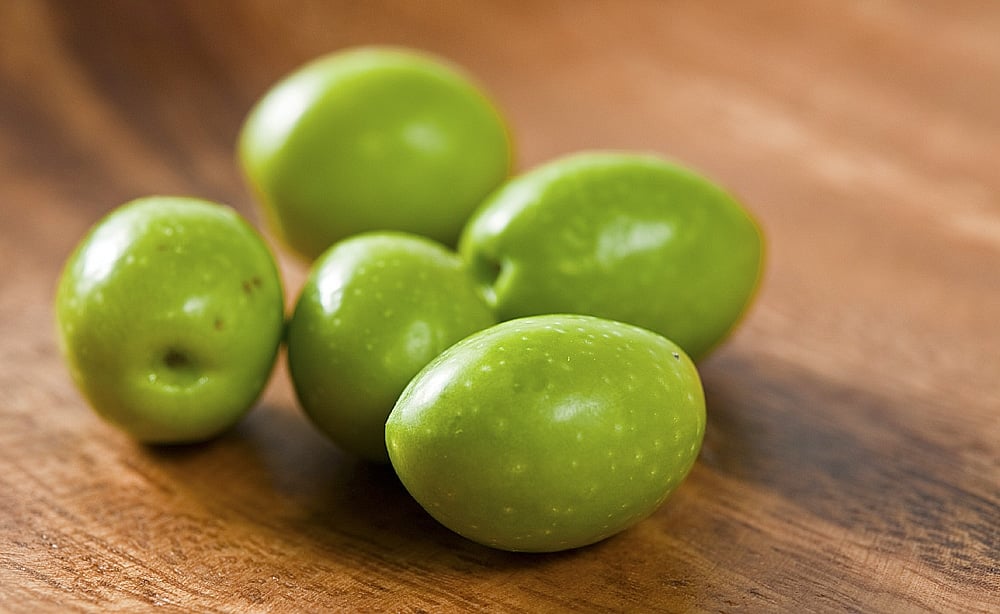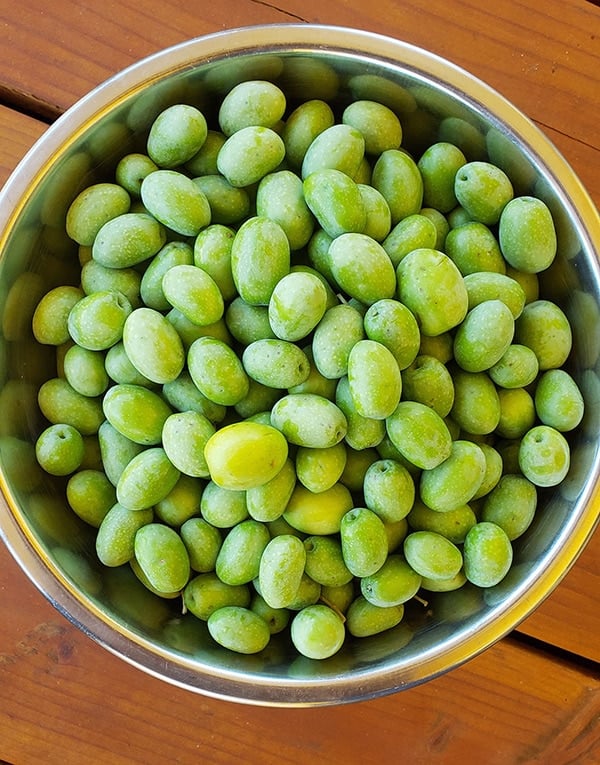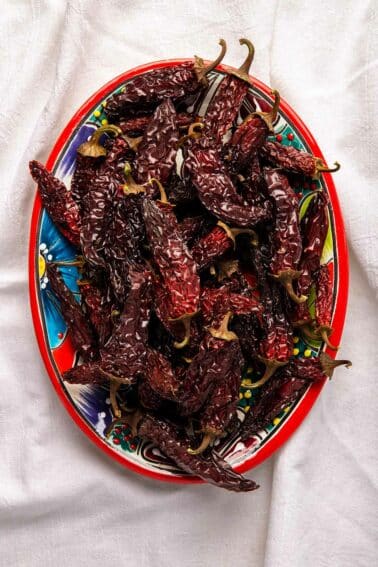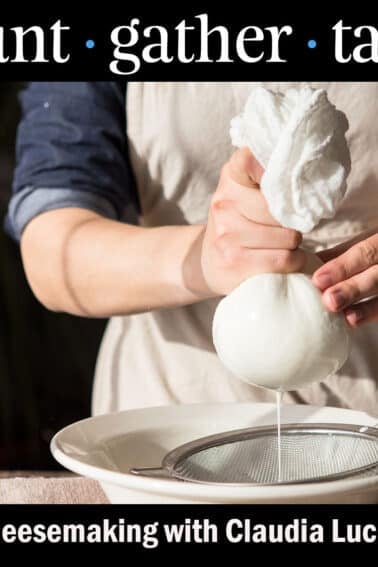As an Amazon Associate I earn from qualifying purchases.

Lye. Isn’t that the stuff the Mafia uses to dissolve the bodies of those who’d made an unfortunate choice to use another waste disposal or vending machine company? Isn’t it drain cleaner, a deadly poison? So how on God’s Green Acre can lye be useful in the kitchen?
Relax. I am here to tell you that lye can be your friend, especially when it comes to curing green olives. Good lye cured olives, I have discovered, are uniquely smooth and luscious in a way that brine or water-cured olives can never be. Done right, they can be <gasp!> even better than a brine-cured olive or an oil-cured olive. Seriously.
Let me start by admitting that I was as terrified about using drain cleaner to cure olives as you are. Intellectually I knew it would work, and knew I’d eaten lye cured olives before, as have most of us: They are those nasty black canned things also known as Lindsay olives. That knowledge, however, did not bolster my desire to do any lye curing anytime soon.
Then I did some research. I’d seen all sorts of references to how the lye cure — actually a cure in water that had percolated through wood ashes, which are a source of lye — being used “since Roman times.”
Many hours of searching later, I found that the Roman agricultural writer Rutilius Taurus Aemilianus Palladius is the source of this, in his De Re Rustica, written in the 300s.
“Mix together a setier of passum, two handfuls of well-sifted cinders, a trickle of old wine and some cypress leaves. Pile all the olives in this mixture, saturate them with this paste in garnishing them with several layers, until you see it reach the edges of the containers.”
Passum is freshly extracted grape juice, so the lye in the ash-water interacting with this would make an interesting brew. There would be so much sugar going on in there that you could get both a lye cure and fermentation going at the same time. Freaky.
Since then the Spanish have been masters of lye cured olives. Most Spanish table olives are cured at least in part with lye, but their process is far different than that used in to make the hideous Lindsay olive. I am modifying a method I found in an agricultural book written in 1817.
Incidentally, other popular modern olives that use a lye cure include the French lucques, Italian cerignola and Spanish manzanilla.
First thing you need to know about lye cured olives is that you must use fresh green olives. Not black ones, not half-ripe ones. The lye process softens the meat of the olive, so you want it as firm as possible.
When you are picking your olives, watch out for olive fly. The larva of this nasty little bug burrows into an olive and eats it from within. Thankfully infested olives are easy to spot: They will ripen faster than healthy olives, and there is a tell-tale scar on the olive that looks like this:

Toss that olive. While the worm is not poisonous, I prefer my olives sans extra protein, thank you.
What sort of lye do you use? The traditional brand to use is the classic Red Devil Lye, which is an old brand of drain cleaner. Drano used to be this way, but apparently has additives now. Don’t use it.
I now buy food grade lye because, well, it’s easy to get on Amazon, and I also like making pretzels at home, too, and they use lye to get that signature crust.
Isn’t lye a deadly poison? Sorta. Sodium hydroxide is one of the nastiest bases we know of; a base is the opposite of an acid. On the PH scale, distilled water is the median, at 7. Your stomach acid’s PH is about 1 1/2 — enough to burn a hole through a rug. Lye’s PH is 13.
Bottom line: Raw, pure lye will burn the hell out of you, but it is not a systemic poison. That means that even if you eat an olive that still has a lot of lye in it — as I did — all you will taste is a nasty soapy flavor. If you eat a bunch of them, the alkaline PH in the olives will counteract your stomach acid and it might give you indigestion. That’s all, and that’s a worst-case scenario.
That said, you need to be careful at that one moment you are moving raw, pure lye from the container to the crock you are curing into.
LYE CURED OLIVES STEP BY STEP
Follow these instructions and you will be fine:
- Wear glasses if you have them. Wear long sleeves and pants and closed shoes. You will probably not get lye on you, but better to be safe.
- Pour 1 gallon of cold — not tepid, not hot, but cold — water into a stoneware crock, a glass container, a stainless steel pot, or a food-grade plastic pail. Under no circumstances should you use aluminum, which will react with the lye and make your olives poisonous.
- Using a measuring device that is not aluminum, add 3 tablespoons of lye to the water. Always add lye to water, not water to lye. A splash of unmixed lye can burn you. Stir well with a wooden spoon.
You’re done. You use cold water because the reaction between lye and water generates heat, and the hotter the lye-water solution, the softer the olives will become. Now that it is mixed, the lye solution can’t hurt you, so go ahead and add your olives.
Stir them in with that wooden spoon and put something over all the olives so they do not float. This is vital. Olives exposed to air while curing turn black. Don’t worry, they will absorb the water and sink in a few hours, but to start you need to submerge them.
Let this sit at room temperature for 12 hours. The alkaline solution will be seeping into the olives, breaking the bonds of the bitter oleuropein molecules, which then exit the olive and go into the water. After 12 hours, pour off the solution into the sink. It should be pretty dark in color.
Quickly resubmerge your olives in cold water. You want to minimize the exposure to air. You now have cured olives.
I know, I know, a lot of recipes say to repeat the lye process another time — sometimes three more times — but that will destroy a lot of flavor; there are a ton of water-soluble flavor compounds in an olive that the lye solution washes away. Trust me. Your olives, unless they are gigantic, will not be overly bitter even after just a light, 12-hour lye soak.
Now you need to cleanse your lye cured olives. They will have a fair bit of lye solution within them now. Keep changing the water 2 to 4 times a day for 3 to 6 days, depending on the size of the olives. After 2 days, taste one: It should be a little soapy, but not too bitter. It’ll be bland, and a little soft. Once the water runs clear you should lose that soapy taste.
Time to brine. If you have large olives, make a brine of 3/4 cup salt to 1 gallon of water. And use good salt if you can. You will taste the difference. Kosher salt is OK, but ideally use a quality salt like Trapani, which is from Sicily. It’s not that expensive, but it is worlds better than regular salt.

Let the olives brine in this for 1 week. Keep them submerged, or you will get darkening. After a while they will sink. After 1 week, pour off the brine and make a new one, only this time, use 1 cup of salt per gallon.
Now you can play. The traditional Spanish cure would add some vinegar to the mix, as well as bay leaf and other spices. I’ve played with adding a touch of smoked salt, chiles, black pepper, coriander, mustard seed, garlic — think Mediterranean flavors.
But before you do this, taste your freshly brined olives. It will be a revelation. They will remain beautifully green, unlike brined olives. Salty, olive-y and very, very buttery. This is the Lay’s Potato Chips of olives. I dare you to eat just one.









Hank. I brined my olives with your ratio of 3 tablespoons of lye to 1 gallon water. I have a 5gallon bucket half full with olives. So used approximately 3 gallons water with 9 tablespoons of lye. Left them for 24 hours drained and rinsed them twice. Rinsed again that evening. The next morning rinsed again and tried one. They seemed really soft. Is this normal. Will they firm up some when I get to the salt and water process. Thanks
12 hours soak not a 24 hour might be the problem
Hank
I have made lye-cured olives for 30 years now. Love them.
This year, for some reason, after putting them in the final 1-1/2 cup salt solution, after several days the started to shrivel or have wrinkled skins.
Any reason why ?????
Hi Hank. I have some Sevillano olives to sure. But some are purplish and not entirely green. Can I still do a lye cure? Or do you recommend a brine method instead? I am worried the purple ones will be too mushy with the lye cure. Thoughts?
Brian: I recommend the longer brine cure once they turn color.
Hi, Hank, Thanks so much for all the advice here. This is my second year doing my olives your way and they taste fantastic! However, I have a few questions: I add garlic and other seasonings for the final brine in the individual jars. After about a week, they are a bit cloudy — especially where the garlic chunks are. They are almost gelatinous around the garlic. What is that? How should I avoid that? Is that compromising the safety of the olives?
Tiffany: That’s fermentation. I wouldn’t add garlic to a brine unless you keep them cool, like in the fridge.
Thanks so much!
If you can your olives, do you put the vinegar in and just plain water or the vinegar with the brine mix
Hank. I’ve been curing olives since 1967. We had 4 olive trees on my street where one of the trees was over 100 years old. I only cured a small fraction of what these trees produced. It was always just in time for Thanksgiving and Christmas dinner with the family.
I used 4 Tbl spoons per gallon of water. Each crock was 10 gallons, and maintained a 50/50 water to olive ratio.
Different size had different cure times.
I started cutting a sample olive down to the pit. I look for the same color from the skin to the pit. This was anywhere from 10 to 18 hours.
Once the same color, I did an immediate rinse, as you outlined for 1 week. Then the brine, using Kosher Salt. Same ratio as yours in the first 10 days. I increased by 10% after that.
when serving, those olives, I soaked them for a couple of hours in fresh water to reduce the salt.
Tossing in 4 to 5 cloves of garlic into each 1 Qt canning jar was a knock out hit with the family.
I agree, you can’t just eat one!
Any cracking or cutting involved before the lye solution or just submerging in lye ?
Al: Nope, no cracking or cutting.
Hi Hank, great recipe! First time curing olives and they’re good so far, your directions are easy to follow. I’m about to start the second brine using 1 cup salt per gallon. Do the olives sit in this for a week and then I rinse them and store them in a new brine? You mentioned in another comment that you don’t add flavor until storage, should I not add garlic and pepper until after the second week then? Would you be willing to clarify the final step? Thank you!
Hank- We have used your recipe now for two years to make multiple batches, with great success. But sometimes getting the timing right for the 12 hour initial lye soak doesn’t work out- would have to be dealing with them at 3 am. What happens if you leave them in the initial lye bath for 16 or 18 hours? Any problem? Or should I just plan to start the process late at night if I can’t get started early in the day? Jennifer
How many pounds of olives will this generally cure?
Eric: About 3 to 5 pounds.
Keen to give this a go! Wondering if anyone has converted this to metric? What is the weight of an American tablespoon of lye/ 3/4 cup salt… Thanks!
One more question for lye curing, no cutting pounding or cracking of the olives, correct?
I assume that’s true for salt curing of mission/Barouni olives as well?
Rob: No, you don’t crack them. Yes, you can brine green olives. The cure works for however many olives will be submerged in that gallon. It can be scaled up. With large olives, the cure might take longer.
Hi, Excited for this. I’m almost ready to start my first brine. How long will they last in a glass jar after the final brine?
Ann: in the fridge, more than a year.
We are at the salt brine.
To clarify, brine in 3/4 cup salt to 1 gallon water for 1 week. Then 1 cup salt to 1 gal water for a week. Then flavor salt and water for storage? Or do you flavor it with the second brine, 1 cup salt with other flavoring for storage?
The end is not clear.
Diane: I don’t add flavors until storage.
When do you store it? With the second brine? After a second week of brine? If so, what is the liquid for the storage? Any requirements?
Diane: Final brine is about 1/4 cup salt to 1 quart water, plus seasonings. Yes, after the second week.
how do you can them after curing?
After processing green olives in lye and then canning salt, the green olives are soft and the outer meat is loose from the inner meat that is attached to the seed. Any comments why this is happening? We are at the point of ready to can the olives. Thanks.
Hi Hank, I Just finished the one week brine and was surprised to see that some of the olives have blisters on them. Do you have any idea what I might have done wrong?
Shawn: Blisters? Never heard of that. Not sure what’s going on.
It’s from the lye being too hot when the olives go in. I mix lye and water and let cool over night to prevent burns.
Robin,
A friend is doing a lye cure on Manzanillo olives. Small blotchy dark spots appeared after they were put into the solution. Most of them go into the flesh. Some are just on the surface. He has cured olives many times and had a few spots but never this many. I can send photos if it helps.
Thanks
Susan: Those are most likely bruises on the olives. It’s not from the cure.
Morning Hank,
I’ve used your process several times and always had great results. This go round all of the larger olives are exceedingly bitter, this is day 3 of the rinse process and I have no soapy taste can I Lye them again or go with a brine?
Paul: I would lye them again.
Hi Hank. I lye cured olives last year using your 12 hour method. They turned out amazing. This year a friend found me some olives that are larger than a quarter. Should I cure them for 48 hours? If so do I change the lye solution after 12 hours? Don’t want to ruin these beautiful olives.
Martha: No need to change the solution, but yes, they will likely need more time to cure. You can check in process by taking one out and slicing it. The cure is visible, so wait until it gets to the pit.
Hi Hank-
We’ve lye-cured the olives in a crock, gone through the cold water rinsing, and we are ready to begin the two 1-week long brining steps.
Looking ahead, the tail end of the article is not clear on when to add flavors.
We’re curing about 2 gallons of olives and plan to pack them in pint jars. Is this when we should add flavors- to the water packed jars of olives? This would give us lots of jars to experiment with different flavors you recommend. Or, if there’s a different stage / step of adding flavors, please let us know.
Thank you for the clarification.
Anthony and Rachel
Citrus Heights.
Anthony: Yes, you add flavors at the end, when you are ready to store the olives for a few months.
Hi, Hank—
I’m just south of you in Lodi and have a couple of Arbequina trees. My olives are ripening unevenly this year (probably attributable to the weird late frost we had just as mine were flowering), so I have about 1/3 green, 1/3 with some color blush, and 1/3 fully ripe/black. I want to lye-cure the green olives, but I’m not sure how to best handle the half-ripe olives (lye or brine?), and not sure if I should brine or salt cure the black ones. Since they’re not huge olives, I’m concerned a salt cure might make them too small/shriveled to be appealing. What would YOU do with this weird mix?
Also, because I love olives marinated in good olive oil, would that also be a good way to keep/preserve them after brining (this also figures into how best to package them for gift jars)? Or just brine them and marinate in oil before I serve them?
Thanks for all the great info!
Robin: The half ripe ones are ideal for brining. I’d also brine some of the all black ones, but wait to salt cure the majority of the black ones until winter. As for the olive oil, yes, I marinate them in batches as I need them, like a jar at a time. They’re fine in olive oil a few weeks, but I would keep the majority in brine until you are more or less ready to eat them.